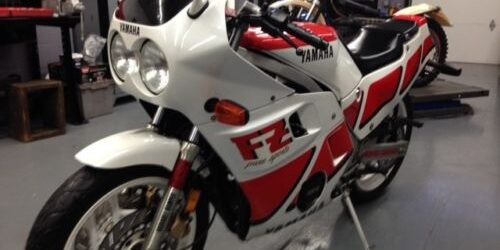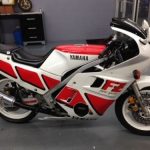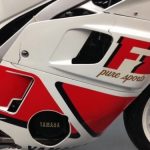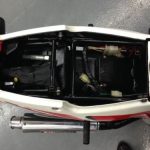The Yamaha FZ600 broke cover in 1986, right as the fully-faired sportbike wave seriously started to swell, and helped start the careers of myriad young racers and hobbyists. When it debuted, it was aimed squarely at the Honda CBR600F and the Kawasaki Ninja 600 and gave its competitors some serious worries at the racetrack.
1987 Yamaha FZ600 for sale on eBay

By 1988, though, the FZ600 had been replaced with the faster, more aggressive and more advanced FZR600, which took the brand to a new level of success and status. That left the FZ as an inexpensive, easily modified and user-friendly entry-level street bike and club racer. As such, they’re rare in nice, unmolested condition.
This 1987 Yamaha FZ600 is the exception to that rule, with just a couple cracks on the right side fairing to show for its 30 years. The seller says it has not been raced, which is a good sign, and the only real deviation from stock is a period-correct Yoshimura exhaust.
From the eBay listing:
RARE 1987 YAMAHA FZR600. 4 CYLINDER – 4 STROKE. UNMOLESTED NEVER RACED — ORIGINAL. 6 SPEED YOSHIMURA EXHAUST. GAS TANK , FRONT FAIRING , SEAT , REAR COWL , AND LEFT HAND FAIRING IN GOOD SHAPE. DAMAGE ON MID AND LOWER RIGHT HAND COWLING. BUT FIXABLE. TWO SMALL CRACKS ON WINDSHIELD THIS CYCLE RUNS AND SHIFTS GREAT.
The ad doesn’t mention maintenance or recent repairs, so it’s a good bet that the bike could use a good once-over, even with only 10,000 miles on the dial. The FZ600s likely will never command huge money, but they are fun, fast, simple and relatively easy to get parts for.
With a little fairing work, this one would make a nice addition to a vintage sportbike collection.

























Great bike! Unfortunately somebody dumped mine in a past life and replaced all the fairings with AirTech (I think) which are much thinner plastic and don’t have the front mounting points for the mid-fairings. Still seriously fun to ride, and honestly it’s a great everyday bike. Surprisingly easy to find parts; it was kind of a parts-bin special. Frame and fairings from an FZ400, engine and carbs from a ’86-’88 YX600 Radian (it’s the FJ600 engine with 30mm instead of 32mm carbs, and a little less aggressive intake cam). Basically the same wheels, gauges, master cylinder, and switchgear as every other late-80s/early-90s Yamaha sport bike. The Yoshimura exhaust sounds great, too! Wish I could buy this one for a spare
With that Yoshi pipe you can include the wheels (should be red) and mirrors (should be black) as non-original parts, although they may in fact be OEM. Nice bike, but he’s shooting for the stars with the buy it now price and the broken plastic.
I have never seen this paint scheme in the US. Usually has dark blue on the upper of the tank and fairing. This looks more like FZR400 graphics and overall colors. Anyone know more about this?
Love this bike – when I first started riding in the late ‘80s this was pitched as an ideal first sport bike… you could pick em up used for only a few grand. This is a bike that should sell quickly at $2500 but the seller will sit on it for a long time at $5500… what would really rather have for the money – this or an R1??
The paint scheme you’re thinking of is the FZ600 PureSports edition (http://www.sportbikerider.us/Pics4/1986-Yamaha-FZ600-3213.jpg). The Wikipedia article says it had “more performance oriented modifications”, and I’ve seen that mentioned in a few places – though I’ve never been able to confirm that it was anything other than a racier-looking paint scheme.
As far as I know, the PureSports version had the same engine with the same cams, Mikuni BS30 carbs, and factory 4-1 exhaust as the version shown for sale here. Michael above questions the wheel color, but as far as I can tell they came from the factory in both red and white (except the PureSports edition, which had black wheels). I’m not sure if this was just an option, or different across model years, or different market-to-market.
I bought a new red, white and blue FZ600 for $2900 out the door in 1986, I don’t remember there being any differences other than sticker schemes. Those were the days my friends.
I think it’s just the difference between the 86 and 87 model year paint schemes. Wonderful bikes these.
“By 1988, though, the FZ600 had been replaced with the faster, more aggressive and more advanced FZR600” – don’t you mean to say “by 1989 the FZ600 had been replaced by the FZR600”? – or are you referring to calendar year events rather than model year? I saw a two-page ad for the new 1989 FZR600 in Cycle World and ran my ass down to the nearest dealer and bought one (in black, just like the ad), so the intro model year for the FZR600 is kinda tattooed on my brain.